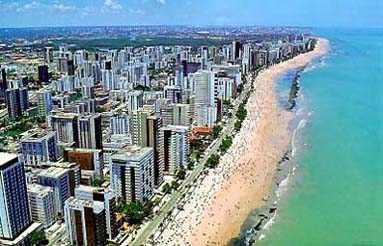 |
Recife, the capital city of Pernambuco state is famous for many reasons: Endless summers, hot crystal waters, sunny beaches, nice people and the Frevo, the brazilian rythm that claims to be even hotter than the Samba. Here, a rare mixture of European settlers and Americans have led to a unique cultural place, where you will cross bridges designed by the Dutch, visit churches built by the Portuguese, taste old indians recipes and enjoy the music and dance brought from Africa to Brazil. This is Recife. |
A good starting point to your visit to Recife is Ground Zero (right), where a bronze signs reads: From this point, all the distances in Pernambuco are measured. Located between the city harbor and Old Town, this area is filled with historic buildings, bars, restaurants and souvenir stores. Specially interesting on friday and saturday nights, when many of the bars have live music shows.
The Old Town was the administrative center of the city, during colonial, and after that became quite abandoned until the 90'. From then on, a revitalization program turned it in a showcase of the city's cultural history, frequented by both locals and tourists. Its main area is along Bom Jesus St, where are some of the best bars, nightclubs and shops. |
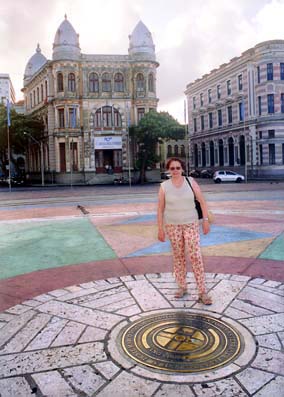 |
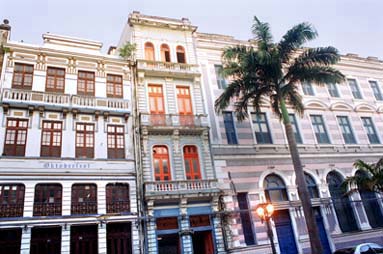 |
One more shot of the Old Town. Recife started around the port, but the original buildings were burned down by the Dutch in the 1600s. The area was rebuilt soon after, though, and there are plenty of beautiful old buildings already restored or under restoration, including South America's first synagogue, built by the Dutch from 1637 to 1644. Recife cuisine is the cuisine of its region, Pernambuco, and the culinary influences of the area can be traced to a dynamic assortment of cultures: Dutch, Spanish, Moors, Africans and Indians. Many dishes come with a delicious coconut sauce, and feature corn, mandioc, fresh seafood, and native fruits. Grilled meats are also big here, especially goat and beef dishes |
At modern Boa Viagem district (right) are located the best hotels in town. Parks, palms, restaurants, shopping, car rental agencies and the wonderful beach facing the buildings, make this a sure bet for tourists. Recife has three main shopping centers, all of them with good restaurants and modern movie theathers: Shopping Recife, one of the largest malls in Brazil, Tacaruna Mall and Shopping Guararapes . Tourists must also remember that when it comes to rythms and dance, Recife is surely special. Not only thanks to the traditional and well known Frevo but also Maracatu, Caboclinho and Ciranda, all very popular in northeast Brazil. A walk along the beach may turns into a showcase of those rythms. And, those visiting Recife during Carnival time, may be surprised to find out that this city has the largest Bloco de Carnaval in the world, the famous Galo da Madrugada (Early morning rooster), which gathers together more than one million people on the city streets. By the way, in case you are not familiar with the expression, a Bloco de Carnaval is a group of people, usually wearing similar carnival outfit and dancing to the same rythm, not necessarily choreographed, as a kind of informal Samba School. |
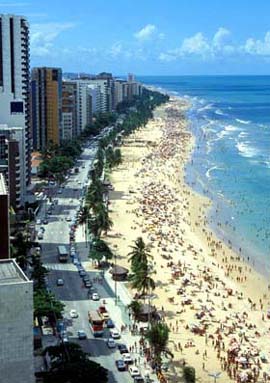 |
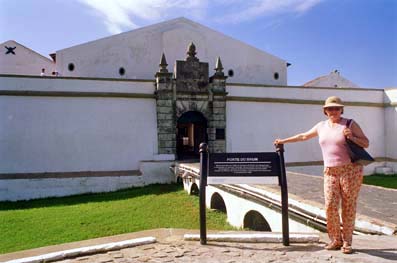 |
Recife's weather is tropical. Its proximity to the Equator blesses it with a warm, almost unchanging temperature which usually lies somewhere between 28° and 34°C. Heavy rains make daily visits during the main winter months of June and July, and the heat reaches its peak from mid-December to February, when locals typically go on vacation. At left, Recife's Old Fort, built centuries ago by the portuguese. |
Recife's many rivers are Beberibe and Capibaribe. Thanks to the many islands, canals and bridges, the city got its nickname Brazilian Venice. Once a fisherman's village, It is now one of the major ports in this part of the country, and one of the number one destinations in Brazil to many tourist coming from America and Europe. Many tour operators offers Catamarans Boat tours, along the city canals as well as across the sea along the city beaches. At left a tipical artcraft from Recife. |
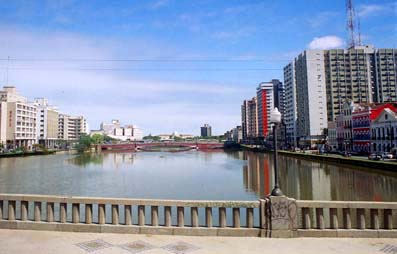 |
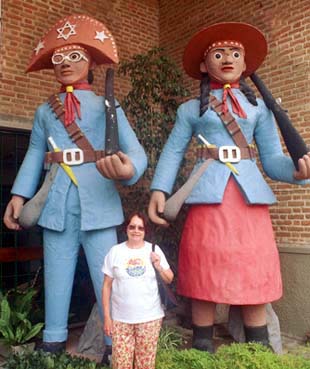 |
Casa da Cultura, located downtown, was once a colonial prision, but now is the best places in town to find souvenirs and traditional arts. Traditional music and dance shows are also performed outside this cultural arts center. Also at Feira do Terminal de Boa Viagem, an open air fair located at the south end of Boa Viagem Ave offers artcraft, ceramic, gifts, musical instruments and the famous small painted clay figures representing local figures. The photo at left was not shot at Recife, but at the city of Caruaru, one hour drive from Recife, at the entrance of Museu do Barro (Clay Museum).
This huge clay figures are large scale replicas of Mestre Vitalino work, that became world famous. He started molding clay still as a child, and had no one to teach him the technics. Even so, soon he was molding everything, inspired by what he could see around him: Children playing, dancers, soldiers, animals... Today his art is one of the most important symbols of northeast brazilian art. |
Traditional souvernirs, made of clay, available everywhere in Recife. |
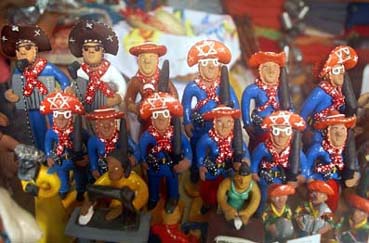 |
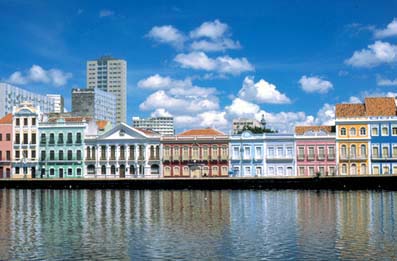 |
The coastal city of Recife, on the Golden Coast of northeastern Brazil, presents a contrast of colonial and modern buildings. Facing them, reefs can be seen along all Recife coastline. Actually they named the town as Recife's name was derived from the Portuguese word for reef, referring simply to the city's situation behind a long and protective coastal reef. The coast of Pernambuco state is almost 150 miles long, and is surely one of the most beautiful in Brazil. At right, Recife's historic quarter. |
After visiting Caruaru and Museu do Barro, go even further to New Jerusalem. It is a replica of the ancient town as it was two thousand years ago, surrounded by a stone wall and seventy towers, spreading in an area of seventy thousand square meters, making this the largest open-air theater in the world. During Holy Week, the story of Christ's Passion and Death is presented to thousands of viewers. Five hundred actors, utilizing twelve stages, perform the life and the process of Jesus, in sixty scenes of extraordinary and beautiful realism. New Jerusalem is open for tourist all year round, although the show is performed only during the Holy Week. Details at Pousada da Paixão and Nova Jerusalem web sites. |
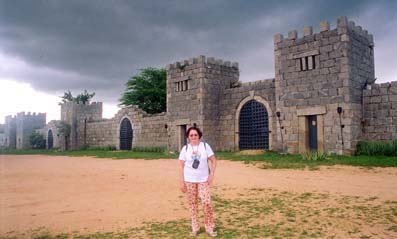
|
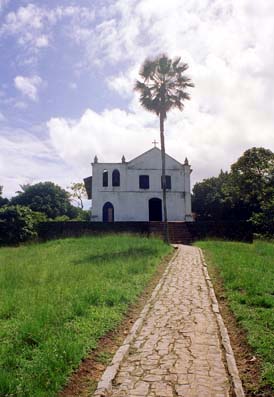 |
On your way to Porto de Galinhas, try to visit also Engenho Massangana (right), one of the many old colonial sugar cane plantations. There can still be seen the main mansion, chapel, slaves dormitory and everything related to the hard time they had at that time. This place was one of the first to abolish slavery in Brazil |
|
Located south of Recife, Porto de Galinhas (right) is a number one destination spot for those looking for dreamlike places. Strangely enough, it means Chickens Harbor, because in the past it served as a slavery port. During the 18th century, when slaves traffic became a felony, chicken was the code name used. There are new chickens in town meant that a ship loaded with slaves had just arrived. The beach line is 10 miles long, all with white, fine grained, clean sand. There is a chain of reefs lining all along the coast. During the lower tide, the water trapped by the reefs forms several natural pools, where people can swim and dive. |
 |
 |
But even after having became a famous touristic spot, Porto de Galinhas is still a fishing village, a small place that has kept its characteristic rustic fishermen architecture. Tourists will find many bars, refined restaurants, great nightclubs, small inns and two or three luxury hotels. The main attraction is its crystal clear natural pool made up of reefs with always warm water. But it also offers visitors a wide array of touristic options, not only every kind of water sports, but also Jangada Boat tours, trails, biking and hiking. |
The Carranca, at left, was maybe the most important part of every brazilian boat along inland rivers. According to old legends, those ugly faces had the task of scaring water demons, backing them off, and doing so, would provide a smooth jorney to those on board. Today their job is just posing for tourist's digital cameras at Boa Viagem beach.
Recife is the second largest city in the northeast area, and the 5th largest metropolitan area in Brazil. It is served by several daily flights to Guararapes International Airport from all major Brazilian cities. It is one of those places that wherever you go, you are bound to find hiking trails, glorious beach communities, and fantastic architectural sites, always with a soundtrack: the Frevo!
Video: Taking off from Recife |
 |

|
|
|